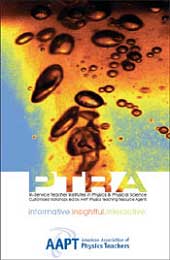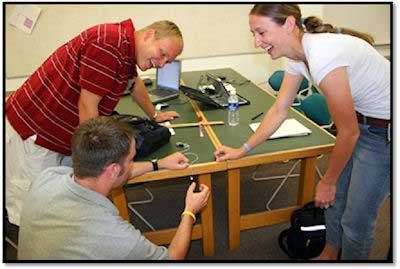AAPT/PTRA Professional Development Program:<br>A Model For Successful Teacher Professional Development
Teacher Preparation Section
Jim Nelson
This article was excerpted from a more detailed description of the program available at http://ptec.org.
With the help of National Science Foundation (NSF) and American Physical Society (APS) funding, the American Association of Physics Teachers (AAPT) has developed the Physics Teaching Resource Agent (PTRA) model for physical science and physics teacher professional development. This model includes development of peer mentors and professional development leaders, systemic infrastructure, assessment instruments, and a curriculum based on experienced mentors and physics education research.
Components of AAPT/PTRA Professional Development Program
The features included in the AAPT/PTRA Professional Development Model are:
- A consistent and known curriculum for Professional Development consisting of the sequence of Kinematics, Newton's Laws, Energy, Momentum, Electricity (DC Circuits and Electrostatics), Waves, Optics, and Sound. A consistent and logical sequence of professional development events over a period of time has a much better rate of success than a random collection of events.
- Each AAPT/PTRA curriculum Teacher Resource Guide has been developed by experienced and knowledgeable high school physics teachers. This assures that the activities and instructional techniques in the Teacher Resource Guide are effective, both during the professional learning experience and when teachers use the activities in their classrooms. Each AAPT/PTRA Teacher Resource undergoes rigorous review by the Publication Committee of the AAPT. The review process assures that the content and pedagogy of the AAPT/PTRA Teacher Resource Guides are world-class. Consistent curriculum at all sites is based on AAPT/PTRA Teacher Resources Guides and leadership training in order to facilitate system wide AAPT/PTRA evaluation.
- AAPT/PTRA mentors and leaders undergo yearly training in researched-based pedagogy including guided inquiry, instructional use of technology, and AAPT/PTRA curriculum and content so that they are better prepared as role models for new and crossover science teachers. This approach takes advantage of the old adage, "Teachers teach the way they were taught."
- A college or university professor is selected to be the Regional Coordinator (RC) for the site. Although the AAPT/PTRA professional development model does not use the college or university professor as teacher within the program, he or she is an important component of the collaborative support structure.
- The AAPT/PTRA Program is committed to provide over 100 hours of consistent professional development for participants.
- The AAPT/PTRA Program has developed formative and summative content assessment instruments for use with second-tier participants.
- Full commitment for three summers and two follow-up sessions per year is expected of participants who attend AAPT/PTRA Summer Institutes.
- More information about the AAPT/PTRA Program
AAPT/PTRA Goals & Activities
The AAPT/PTRA Program goals include providing an opportunity for upper elementary, middle, and high school teachers to experience professional growth in the areas of physics and physical science content (e.g., Kinematics, Energy, Newton's Laws), use of technology (e.g., electronic measurements, graphic calculators, simulations), and teaching techniques based on physics education research.

- Evidence of Content Knowledge
- Evidence of Creativity in Teaching
- Evidence of Interest in Personal Professional Growth
- Evidence of Leadership Potential
A Boston College study, TIMSS (Third International Mathematics and Science Study) Physics Achievement Comparison Study, published in April 2000 shows that students of teachers who have attended NSF funded projects, such as AAPT/PTRA Professional Development Program, performed significantly better on the TIMSS physics assessment. The USA overall mean is 423 while the mean for students of teachers who have attended NSF sponsored professional development is 475. In addition, Horizon Research has documented the success of the AAPT/PTRA Program. This study shows that teachers who attend AAPT/PTRA workshops are more confident in their own physics content knowledge and thus are more likely to make a commitment not only to use the technology, but also to use the results of successful and research-based teaching strategies (e.g., modeling, directed guided inquiry, self-directed learning, ranking tasks).
The AAPT/PTRA workshops are of two types: content specific and teaching strategy specific. Content specific subjects include Kinematics, Energy, Geometric Optics, Momentum, Newton's Laws, the Electromagnetic Spectrum, etc. Workshops dealing with teaching strategies include the Role of the Laboratory, Use of TI-84 in Teaching Physics, Role of Demonstrations, Guided Inquiry, etc.

Teachers enjoying learning during an AAPT/PTRA summer institute
Outline Of A Typical AAPT/PTRA Weeklong Institute: Kinematics/Motion
Compare/Contrast/Measurement: Time as an Instant, Frequency, Time as an Interval, and Period Using Pendulum and/or Flashing Light.
- Measurement of Time Intervals
- One-Second Timer Challenge
- Pendulums on Parade
- Period of a Pendulum using a Photogate
- Frequency versus Period using a Flashing Light
Compare/Contrast/Measurement: Position, Distance Traveled, and Displacement
- Traveling Washer in One Dimension
- Traveling Washer in Two Dimensions
- Where am I?
Compare/Contrast/Measurement: Speed and Velocity
- Toy Car moving with Uniform Linear Motion
- Toy Car moving with Uniform Circular Motion
- Movement of Waves (Wave Equation compared to Speed Equation)
- Instantaneous Speed, Average Speed, Initial Speed, and Final Speed Using a Toy Car Coasting Down an Inclined Plane using a Photogate Timer
- Analysis of Motion Using Graphs Made from a Ticker Tape Timer
Compare/Contrast/Measurement: Acceleration Using Toy Cars and Toy Airplanes
- Speeding Up
- Speeding (Slowing) Down
- Changing Directions
- Measuring Acceleration with a Liquid Level Accelerometer
- Linear Acceleration and Circular Motion Acceleration
Calculations using Basic Kinematics Definitions, Graphs, and Equations
- Position versus Time Graphs (Motion Probe)
- Velocity versus Time Graphs (Motion Probe)
- Acceleration versus Time Graphs
- Basic Linear Kinematics Equations
- Freely Falling Objects (Free-Fall Timing)
- Basic Uniform Circular Kinematics Equations
All of these topics are developed with inquiry-based laboratory activities.
Jim Nelson has been leader of the Physics Teaching Resource Agent (PTRA) program since 1984. Jim currently teaches at Santa Fe College in Gainesville. He earned a Master Degree in Education (1963) from Temple University in Philadelphia and a Masters Degree in Physics (1968) from Clarkson University in Potsdam NY. He received the Presidential Award for Excellence in Science Teaching (1985), the Distinguished Service Award from the American Association of Physics Teachers (AAPT), the AAPT Award for Excellence in Pre-College Physics Teaching (2000), and numerous other national awards for educational excellence.
Disclaimer - The articles and opinion pieces found in this issue of the APS Forum on Education Newsletter are not peer refereed and represent solely the views of the authors and not necessarily the views of APS.
